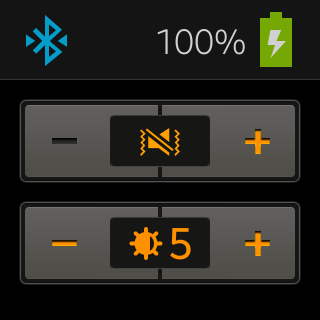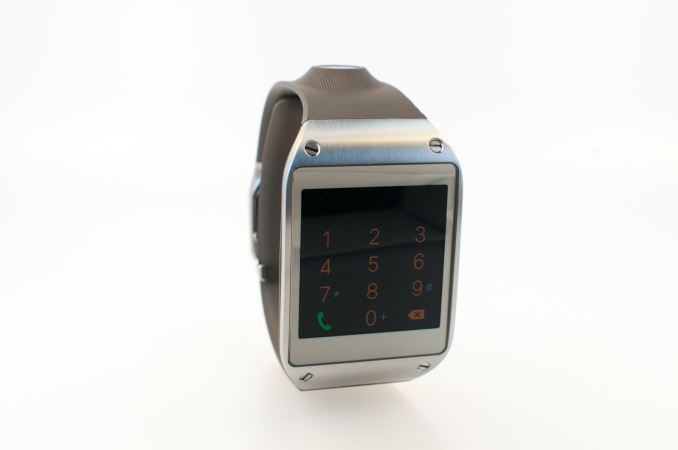Samsung Galaxy Gear Review
by Brian Klug on October 1, 2013 9:00 AM EST- Posted in
- Wearables
- Smartphones
- Mobile
- Galaxy Gear
- galaxy note 3
- watches
Battery Life
Gear’s designers went in a direction that completely defies most of the norm we’ve seen in this latest crop of smartwatches. Rather than the low power Cortex M3 route that seems to be popular, Samsung went with a dual core SoC (Exynos 4212), disabled a core, and set the CPU frequency to a maximum of 800 MHz. On top of the whole thing runs Android 4.2.2 and the Gear software, making the watch more like a small smartphone. The combination of aggressive display timeout (with a maximum of 5 minutes) and the activation gesture for waking the watch up signals to me that battery life probably was a challenge on the Gear.
I don’t really know what the best way is to battery life test a watch yet, and I struggled with that while trying to review Pebble. I settled on just timing how long I got through a battery charge there, which ended up being almost exactly a week (7.02 days was my average), which is basically my only context for what smartwatch battery life should be. The Gear obviously has a considerably more powerful platform, display, and capabilities, so it isn’t a shocker that battery life overall is less.
It’s easy to get around the display timeout limitations and just keep the display on Gear turned on forever, displaying the watchface. I ran a rundown test with the watchface set to brightness level 4 (there are levels 1–5 and outdoor brightness) while connected over Bluetooth to the Note 3. Gear managed 5.117 hours of total screen-on time showing the watch face (clock plus weather) connected to Note 3.

Of course the way that Gear is setup which prevents display from being on all the time, battery life during actual use will be longer. I’d say somewhere just over a day would be on the short side, maybe two or three days is possible if you try to stretch it a lot. I placed a few calls and played with Gear a lot one day and almost didn’t make it through, another day I felt like Gear would’ve lasted two had I let the use pattern continue.
The positive side is that thanks to its smaller battery, Gear can charge from completely drained to 100 percent in just under an hour, the simultaneous downside is that you need the charging cradle to do it. If you’re comfortable charging the Gear daily, it’s survivable, the question is whether consumers are willing to adopt the daily charge requirements of another device. I’ve gotten in the habit of plugging Pebble in every night, so this isn’t a big deal for me, but I also enjoy having a week of battery life when I go travel. I suspect that’s a use pattern that others can empathize with when considering Gear, which guarantees a little over a day of use realistically, and a bit more if you’re careful.











70 Comments
View All Comments
name99 - Tuesday, October 1, 2013 - link
You mean M7 as the low power chip, not A7.(And yes, to stop the screaming rom the peanut gallery, the CURRENT M7 is not really a custom Apple SOC, in the same way that the A4 was not really a custom Apple SOC.
It is, however, a placeholder for Apple's intentions, and I expect over time we will see more and more of the low performance low power always-on stuff move to that chip. The finger print sensor for example, the MEMS sensors --- if it's possible to fab them on the same chip as logic --- and perhaps some sniffers for BT and WiFi which give control to the real WiFi and BT chip when they detect what looks like a signal.)
tech4tac - Tuesday, October 1, 2013 - link
No, I do mean the Cortex-A7. It's an ARM design for low power to run as a companion with or without the Cortex-A15.name99 - Tuesday, October 1, 2013 - link
Ah, OK. Fair enough.(It is rather awful the naming conventions in this space, isn't it? Couldn't Apple have called their series of chips the I4, I5, I6, I7?)
phoenix_rizzen - Wednesday, October 2, 2013 - link
It's only awful when people try to shorten things and drop off important information.Apple A7 vs Cortex-A7 vs A7.
Just saying "A7" is meaningless, especially when the name of the ARM chip is Cortex-A7 (note the hyphen).
Kepe - Tuesday, October 1, 2013 - link
I paused for the first picture of the article for a while and thought just what the hell are those slot screws doing on the front of the thing, pointing in all directions like that. They look absolutely horrible and would be a deal-breaker if I was in the market for one these things. Also, the idea of sticking Android in to a watch is ridiculous, at least with currently available tech. No matter how "smart" a watch is, it's supposed to have good battery life, show the time 24/7 and resist the wear of daily usage including bumping your hand into something, washing your hands or taking a shower.Spaz888 - Wednesday, October 2, 2013 - link
You carry your smartphone with you and now you want to wear an ugly watch connected wireless as well? Does any one wear watches any more except girls as fashion statements? Besides, with all these EMF radiation is it really a good thing to have all these devices around with you on? And what about charging? Sounds like a lot of hassle. Men will be forced to wear man purses just to carry all these things around.UNHchabo - Wednesday, October 2, 2013 - link
I wear a watch daily, but I tend to prefer mine to be relatively lightweight and low-profile.I like a watch because it means I can tell time quickly; it usually takes less than 2 seconds, and I can do it while sitting down, or while my hands are busy with other things like washing my hands. Meanwhile, I can't imagine most people being able to take their phone out, check the time, and put it away, in less than 10 seconds, especially as smartphones have trended larger and pants have trended slimmer.
One of my coworkers noted that the divide seems to be about age 25 right now; you hardly see anyone younger than that wearing a watch, whereas many people older than that do.
If I could add a small monochrome LCD screen to my watch to give me the same information as my phone's lockscreen, that would be perfect -- it could tell me if I had new voicemail, or the phone number of the person calling me, so that I would know whether to bother taking my phone out of my pocket. A vibration motor would also be useful, especially since most women carry their phone in their purse, so in circumstances where you don't want your ringtone on, you can still tell if your phone is going off.
Gorgenapper - Friday, October 4, 2013 - link
I can check the time on my Galaxy S4 Active in around 4 - 5 seconds, using casual movements and not being in a hurry. 2 seconds if I try hard. But then I don't wear skinny jeans.gnx - Wednesday, October 2, 2013 - link
I dream of the day when there will no longer be any fanboy wars. When isheep and androidbots can graze together in the pastures of comments.Beyond that, this rather surprisingly positive review got me thinking, I) to the reviewer must have pretty thick wrists to not find the size uncomfortable and ii) he is a real hardware geek who appreciates the engineering of smartphone internals into a watch.
meacupla - Wednesday, October 2, 2013 - link
Right...but I ditched my wrist watch because my phone kept time better and I don't like wearing bulky wrist watches to start with.
Why doesn't samsung use their flexible OLED screen in something thinner and more, flexible?